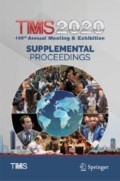Abstract
Mass transport is an important factor in the deposit quality of copper electrowinning . Presently, there is limited diffusivity data available at commercially relevant concentrations between 25 and 40 ℃. Linear sweep voltammetry at a rotating disk electrode was used to measure effective diffusion coefficients of cupric ion for a wide range of copper concentrations (10–50 g/L), sulfuric acid concentrations (120–240 g/L), and temperatures (25–60 ℃). The results were well correlated by the equation: D, m2/s = 2.977 × 10−10–5.462 × 10−13 [Cu]—1.212 × 10−12 [H2SO4] + 1.688 × 10−11 × T, where [Cu] and [H2SO4] are in g/L, and T is ℃. Addition of 20 mg/L Cl− slightly increased effective diffusivity. Other common commercial organic smoothing agents were found to have no effect. The measured diffusivities were used to calculate the “maximum permissible current density” that can produce smooth dense cathodes as a function of copper concentration and temperature.
Access this chapter
Tax calculation will be finalised at checkout
Purchases are for personal use only
References
The World Copper Factbook (2018). International Copper Study Group. http://www.icsg.org. Accessed 15 Aug 2019
Al Shakarji R, He Y, Gregory S (2011) Statistical analysis of the effect of operating parameters on acid mist generation in copper electrowinning. Hydrometallurgy 106(1–2):113–118
Hrussanova A, Mirkova L, Dobrev T, Vasilev S (2004) Influence of temperature and current density on oxygen overpotential and corrosion rate of Pb–Co3O4, Pb–Ca–Sn, and Pb–Sb anodes for copper electrowinning: Part I. Hydrometallurgy 72(3–4):205–213
Qin X, Gao F, Chen G (2010) Effects of the geometry and operating temperature on the stability of Ti/IrO2–SnO2–Sb2 O5 electrodes for O2 evolution. J Appl Electrochem 40(10):1797–1805
Gang X, Qian Z (2014) The stability of copper extractants in acidic media. In: ALTA 2014 Nickel-Cobalt-Copper, Perth, Australia, 2014. ALTA Metallurgical Services, pp 281–291
Ibl N, Javet P, Stahel F (1972) Note on the electrodeposits obtained at the limiting current. Electrochim Acta 17(4):733–739
Uceda D, O’Keefe T (1990) Electrochemical evaluation of copper deposition with gas sparging. J Appl Electrochem 20(2):327–334
Ettel V, Tilak B, Gendron A (1974) Measurement of cathode mass transfer coefficients in electrowinning cells. J Electrochem Soc 12(7):867–872
O’Keefe TJ, Cuzmar J, Chen S (1987) Calculation of mass transfer coefficients in metal deposition using electrochemical tracer techniques. J Electrochem Soc 134(3):547–551
Ettel V, Gendron A, Tilak B (1975) Electrowinning copper at high current densities. Metall Mater Trans B 6(1):31–36
Gendron A, Ettel V (1975) Hydrodynamic studies in natural and forced convection electrowinning cells. Can J Chem Eng 53(1):36–40
Wang H, Chen S, O’Keefe T, Degrez M, Winand R (1989) Evaluation of mass transport in copper and zinc electrodeposition using tracer methods. J Appl Electrochem 19(2):174–182
Degrez M, Winand R (1984) Determination des parametres cinetiques de l’electrodeposition du cuivre a haute densite de courant. Cas des solutions sulfuriques sans inhibiteur. Electrochimica Acta 29(3):365–372
Ilgar E, O’Keefe T (1997) Surface roughening of electrowon copper in the presence of chloride ions. In: Aqueous Electrotechnologies: Progress in Theory and Practice, pp 51–62
Nicol M, Zhang S, Kwang Loon Ang A, Fiorucci A (2013) Mass transport to cathodes in the electrowinning of copper. In: Paper presented at Copper, 2013, 8–10 April 2013
Hotloś J, Jaskula M (1988) Diffusion coefficients of silver ions in CuSO4 + H2SO4 solutions. J Electroanal Chem Interfacial Electrochem 249(1–2):123–132
Bard AJ, Faulkner LR (1980) Electrochemical methods: fundamentals and applications. Wiley, New York
Newman J (1966) Schmidt number correction for the rotating disk. J Phys Chem 70(4):1327–1328
Hinatsu JT, Foulkes FR (1989) Diffusion coefficients for copper (II) in aqueous cupric sulfate-sulfuric acid solutions. J Electrochem Soc 136(1):125–132
Quickenden T, Jiang X (1984) The diffusion coefficient of copper sulphate in aqueous solution. Electrochim Acta 29(6):693–700
Moats MS, Hiskey JB, Collins DW (2000) The effect of copper, acid, and temperature on the diffusion coefficient of cupric ions in simulated electrorefining electrolytes. Hydrometallurgy 56(3):255–268
Kalliomäki T, Wilson BP, Aromaa J, Lundström M (2019) Diffusion coefficient of cupric ion in a copper electrorefining electrolyte containing nickel and arsenic. Miner Eng 134:381–389
Gladysz O, Los P, Krzyzak E (2007) Influence of concentrations of copper, levelling agents and temperature on the diffusion coefficient of cupric ions in industrial electro-refining electrolytes. J Appl Electrochem 37(10):1093–1097
Price DC, Davenport WG (1981) Physico-chemical properties of copper electrorefining and electrowinning electrolytes. Metall Trans B 12(4):639–643
Araneda-Hernández E, Vergara-Gutierrez F, Pagliero-Neira A (2014) Effect of additives on diffusion coefficient for cupric ions and kinematics viscosity in CuSO4–H2SO4 solution at 60 C. Dyna 81(188):209–215
Vanysek P (2000) Ionic conductivity and diffusion at infinite dilution. CRC Handb Chem Phys 83:76–78
Moats MS (2018) Energy efficiency of electrowinning. In: Energy efficiency in the minerals industry. Springer, pp 213–232
Popov K, Maksimović M, Djokić S (1981) Fundamental aspects of pulsating current metal electrodeposition III: Maximum practical deposition rate. Surface Technol 14(4):323–333
Author information
Authors and Affiliations
Corresponding author
Editor information
Editors and Affiliations
Rights and permissions
Copyright information
© 2020 The Minerals, Metals & Materials Society
About this paper
Cite this paper
Bauer, J., Moats, M. (2020). Effective Copper Diffusion Coefficients in CuSO4–H2SO4 Electrowinning Electrolytes. In: TMS 2020 149th Annual Meeting & Exhibition Supplemental Proceedings. The Minerals, Metals & Materials Series. Springer, Cham. https://doi.org/10.1007/978-3-030-36296-6_114
Download citation
DOI: https://doi.org/10.1007/978-3-030-36296-6_114
Published:
Publisher Name: Springer, Cham
Print ISBN: 978-3-030-36295-9
Online ISBN: 978-3-030-36296-6
eBook Packages: Chemistry and Materials ScienceChemistry and Material Science (R0)

